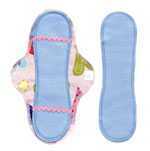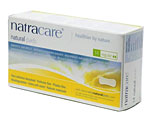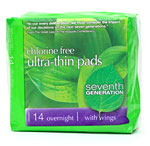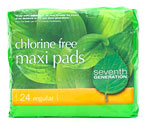
Editor’s Note: This is the first of a two-part series on feminine products. The second column focuses on tampons and menstrual cups.
Suffering the curse. Surfing the crimson wave. Being on the rag. Falling to the communists. Call it what you will, menstruation is a monthly reality for most women. And it’s not exactly a party for the planet.
The average woman will menstruate for about four decades and use an estimated 16,800 sanitary pads or tampons in the process — that’s 250 to 300 pounds of waste. In the U.S. alone, some 12 billion pads and 7 billion tampons are disposed of annually. Add to that the questionable contents of said items — synthetic fibers and chemical-soaked cotton — and it’s no wonder that time of the month isn’t a pleasant one.
Grist’s Pick
Lunapads Organic Cotton Maxi Pad and Liner
Seventh Generation Chlorine-Free Ultra-thin
But what’s the alternative? Well, that’s where it gets complicated. If Mother Earth’s the only consideration, the answer may be an easy one. But Aunt Flow’s a difficult guest, and many different factors — like convenience, comfort, and cost, not to mention squeamishness — come into play.
With this in mind, the courageous women of Grist volunteered to share their experiences with a number of alternative feminine products. In this first of a two-column series, we examine, um, outerwear — including washable cotton pads and biodegradable disposables. Although our staffers had differing opinions about the products they reviewed, everyone agreed it was a bloody good time.

GladRags Organic Cotton Maxi Pad and Liner
Eco-claims: Reusable for up to five years; available in organic, undyed cotton
Capacity/Length of use: Overnight
Leakage: Minimal
Odor: Not much
Comfort: Significantly more breathable than your average plasticky pad, but also much thicker — and downright diaper-like if you’re used to an ultra-thin pad.
GladRags feature an outer pad into which you put one or two (or more) inserts to increase absorbency. The plus side is that the system seems slightly more secure than holding the insert in place with elastic (see Lunapad, below), but the downside is the need to wash the outer pad once you’ve used it, as opposed to just washing the insert. Several ladies mentioned the “ick factor” of having to soak and rinse the soiled pad and liner after use — and before putting them in the washer. One reviewer who has used GladRags for about a decade recommends rinsing the soiled pads by putting them on the tub floor while showering — and says they’ve held up well, even after many washings.

Lunapads Organic Cotton Maxi Pad and Liner
Eco-claims: Reusable for at least three years; available in organic cotton
Capacity/Length of use: Overnight
Leakage: Minimal
Odor: Not much
Comfort: Similar to the GladRags in both breathability and unfortunate diaper-like effect, but the Lunapad is slightly softer cotton
Reviewers said that washing just the insert was convenient, and despite the seemingly flimsy rickrack elastic holding it in place, the insert didn’t move. The Lunapad is also slightly longer than the GladRag. Overall, if you’re used to a conventional, slightly plasticky thin pad, both of these reusable options could disappoint with their thickness — especially for day use. One reviewer dubbed her Lunapad the “Pussy Cushion” and noted that she developed a “camel foot” while wearing leggings and needed to adjust her chair and car mirrors due to the pad’s added height.

Natracare Ultra Pads
Eco-claims: Free of chlorine bleach, perfumes, rayon, plastics, and other synthetics; made with natural materials, including plant cellulose and organic cotton; 90 percent biodegradable
Capacity/Length of use: Up to six hours
Leakage: None to moderate
Odor: Moderate
Comfort: Breathable and discreet
This pad is comparable to conventional pads in terms of usage, but reviewers said it feels more breathable, softer, and, well, natural — noticeably missing is that plasticky sound and feeling. It’s also very slim and discreet, so you “don’t really notice it in your underoos,” as one reviewer put it. The product could use a better “wing deployment system,” however, as it can get bunched up or stick to itself during use. And one reviewer said it was too short and didn’t provide enough coverage for physical activities.

Natracare Curved Regular Pad
Eco-claims: Free of chlorine bleach, perfumes, rayon, plastics, and other synthetics; made with natural materials including plant cellulose and organic cotton; 90 percent biodegradable
Capacity/Length of use: Up to six hours
Leakage: Moderate
Odor: Moderate
Comfort: Thick, but extra-soft
This more traditional maxi-style version of the Natracare pads is extra soft, even pillow-like, but didn’t seem to offer much more in terms of absorption. The pad is also a little too short, which could cause leakage worries on heavier-flow days. One point to note about Natracare products is that the pads don’t come individually wrapped. One reviewer praised the company for this effort to reduce waste and criticized Seventh Generation for individually wrapping its products. But another had this to say: “I’m sure this is better for the planet, but when I’m on the go, I don’t want to carry around a giant box or baggie full of pads!”

Seventh Generation Chlorine-Free Ultra-Thin Overnight with Wings
Eco-claims: Chlorine free with a wheat-based absorbent core; recyclable packaging
Capacity/Length of use: Up to eight hours (depending on flow)
Leakage: Very little, thanks to the wings
Odor: Same as most maxi pads
Comfort: Very thin, practically unnoticeable
These are as thin as many of the conventional pads, while being both wide and long enough for the “overnight” protection they promised. The wings kept the pad in place quite well with very little bunching or curling. And despite being so thin, the pads turned out to have “tremendous” absorption power.

Seventh Generation Chlorine-Free Maxi Pads
Eco-claims: Chlorine free with a wheat-based absorbent core; recyclable packaging
Capacity/Length of use: Up to six hours (depending on flow)
Leakage: A lot
Odor: Strong
Comfort: Feels like a pillow in your drawers
This pad is thick and diaper-like, reminiscent of the generic offerings of the middle-school nurse. It was also deemed too short, and tended to “bunch up if you move around at all,” leading to lots of leakage. The wingless version only exacerbates this problem.
The bottom line: If you don’t mind washing and reusing your pads, the best choice is the softer, easier-to-use Lunapad. If you really need to throw those suckers out, try Seventh Generation’s Ultra-Thin Pads. And if you’re not a pad person, tune in on Nov. 18 for our tampon review!

